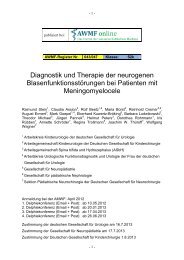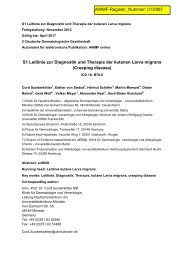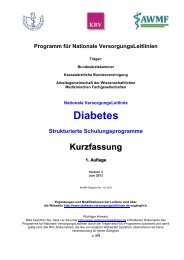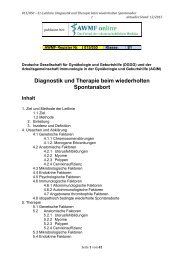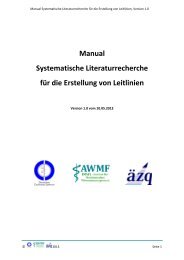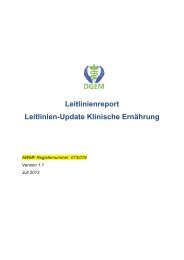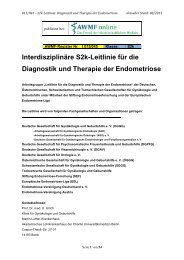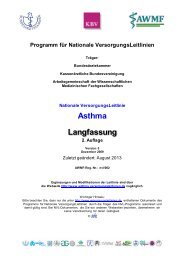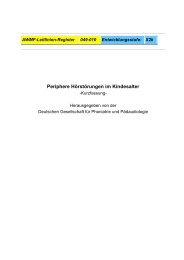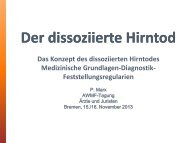Lokaltherapie chronischer Wunden bei Patienten mit den ... - AWMF
Lokaltherapie chronischer Wunden bei Patienten mit den ... - AWMF
Lokaltherapie chronischer Wunden bei Patienten mit den ... - AWMF
Sie wollen auch ein ePaper? Erhöhen Sie die Reichweite Ihrer Titel.
YUMPU macht aus Druck-PDFs automatisch weboptimierte ePaper, die Google liebt.
S3-Leitlinie 091-001 „<strong>Lokaltherapie</strong> <strong>chronischer</strong> <strong>Wun<strong>den</strong></strong> <strong>bei</strong> <strong>den</strong> Risiken CVI, PAVK und Diabetes mellitus“<br />
183. Trautmann M, Halder S, Lepper PM, Exner M. [Reservoirs of Pseudomonas aeruginosa in the<br />
intensive care unit. The role of tap water as a source of infection].<br />
BundesgesundheitsblattGesundheitsforschungGesundheitsschutz. 2009;52(3):339-44.<br />
184. Exner M, Kramer A, Lajoie L, Gebel J, Engelhart S, Hartemann P. Prevention and control of<br />
health care-associated waterborne infections in health care facilities. AmJInfectControl. 2005;33(5<br />
Suppl 1):S26-S40.<br />
185. Vianelli N, Giannini MB, Quarti C, Bucci Sabattini MA, Fiacchini M, de VA, et al. Resolution of<br />
a Pseudomonas aeruginosa outbreak in a hematology unit with the use of disposable sterile water<br />
filters. Haematologica. 2006;91(7):983-5.<br />
186. Bundesministerium der Justiz. Trinkwasserverordnung vom 21. Mai 2001 (BGBl. I S. 959), die<br />
durch Artikel 363 der Verordnung vom 31. Oktober 2006 (BGBl. I S. 2407) geändert wor<strong>den</strong> ist. 2006.<br />
187. O'Toole EA, Goel M, Woodley DT. Hydrogen peroxide inhibits human keratinocyte migration.<br />
DermatolSurg. 1996;22(6):525-9.<br />
188. Baldry MG. The bactericidal, fungicidal and sporicidal properties of hydrogen peroxide and<br />
peracetic acid. JApplBacteriol. 1983;54(3):417-23.<br />
189. Watt BE, Proudfoot AT, Vale JA. Hydrogen peroxide poisoning. ToxicolRev. 2004;23(1):51-7.<br />
190. Daroui P, Desai SD, Li TK, Liu AA, Liu LF. Hydrogen peroxide induces topoisomerase Imediated<br />
DNA damage and cell death. J BiolChem. 2004;279(15):14587-94.<br />
191. O'Meara S, Al-Kurdi D, Ologun Y, Ovington LG. Antibiotics and antiseptics for venous leg<br />
ulcers. CochraneDatabaseSystRev. 2010(1):CD003557.<br />
192. Kramer A, Daeschlein G, Kammerlander G, Andriessen A, Aspöck C, Bergemann R, et al.<br />
Konsensusdokument zur Auswahl von Wirkstoffen für die Wundantiseptik. Zeitschrift für<br />
Wundheilung. 2004(3):110-20.<br />
193. Morgenroth J, Schnitzer R, Rosenberg E. Chemotherapeutic antisepsis. III. A new antiseptic,<br />
2-ethoxy-6,9-diaminoacridine hydrochloride (Rivanol). Dtsch Med Wochenschr. 1921 43:1317-20.<br />
194. Manabe Y, Manabe A. Abortion at midpregnancy by catheter or catheter-balloon<br />
supplemented by intravenous oxytocin and PGF2 alpha. Int J Biol Res Pregnancy. 1981;2(2):85-9.<br />
Epub 1981/01/01.<br />
195. Ingemanson CA. The ethacridine-catheter method in second trimester abortion. In: Zatuchi,<br />
Sciarra, Speidel, editors. In Pregnancy Termination, Procedures, Safety and New Development.<br />
Hagerstown: Harper and Row; 1979. p. 282-9.<br />
196. Brenner S, Barnett L, Crick FHC. The theory of mutagenesis. J Mol Biol. 1961;3:121-4.<br />
197. Lober G, Achtert G. On the complex formation of acridine dyes with DNA. VII. Depen<strong>den</strong>ce of<br />
the binding on the dye structure. Biopolymers. 1969;8(5):595-608. Epub 1969/01/01.<br />
198. Wakelin LP, Waring MJ. Kinetics of drug-DNA interaction. Depen<strong>den</strong>ce of the binding<br />
mechanism on structure of the ligand. J Mol Biol. 1980;144(2):183-214. Epub 1980/12/05.<br />
199. Wugmeister M, Summers WC. A bacterial mutagenicity study of rivanol, an acridine<br />
derivative used as an abortifacient. Yale J Biol Med. 1983;56(1):9-13. Epub 1983/01/01.<br />
200. Dermapharm AG. Fachinformation - Rivanol 1,0 g - Tablette zur Herstellung einer Lösung zur<br />
Anwendung auf der Haut. . 2007.<br />
201. Kramer A, Assadian O. Wallhäußers Praxis der Sterilisation, Desinfektion, Antiseptik und<br />
Konservierung. Stuttgart: Thieme-Verlag; 2008.<br />
202. Edwards J, Stapley S. Debridement of diabetic foot ulcers. CochraneDatabaseSystRev.<br />
2010(1):CD003556.<br />
203. Markevich YO, McLeod-Roberts J, Mousley M, Melloy E. Maggot therapy for diabetic<br />
neuropathic foot wounds.Proceedings of the 36th Annual Meeting of the European Association for<br />
the Study of Diabetes 2000. Diabetologica 2000. 2000;43(1: A15).<br />
204. Thomas S, Andrews AM, Hay NP, Bourgoise S. The anti-microbial activity of maggot<br />
secretions: results of a preliminary study. JTissue Viability. 1999;9(4):127-32.<br />
205. Andersen AS, Joergensen B, Bjarnsholt T, Johansen H, Karlsmark T, Givskov M, et al. Quorumsensing-regulated<br />
virulence factors in Pseudomonas aeruginosa are toxic to Lucilia sericata maggots.<br />
Microbiology. 2010;156(Pt 2):400-7.<br />
Seite 263 von 279 aktueller Stand: 12.06.2012




